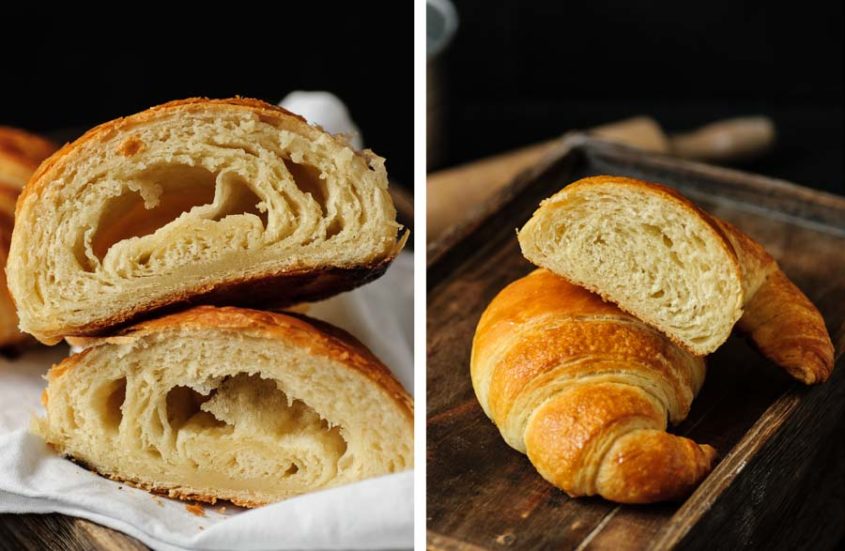Croissants. They seem like a lot of work, so we just buy them at the bakery. Yeah. That is unless you are vegan. No croissants for those butter despisers, right? Because croissants need butter. So vegan croissants can’t be a thing.
Actually are. I make them with margarine all the time. And look how they turn out! If you use the right kind of margarine (In Germany that is Alsan) you won’t even miss the butter.
How to work with coconut oil
You can also make croissants with coconut oil. Atmittedly they will have weaker layers compared to croissants made with margarine. They might look a bit like a roll made from regular enriched dough. But even though they aren’t that perfect, they do taste great! (On the right side you can see a croissant made with margarine. The one on the left was made with coconut oil.


Very sadly my first few batches of coconut oil based croissants ended up in the bin. These layered crescents are not for novice bakers anyway, but working with coconut oil makes them even harder to produce. That is, if you follow the instructions for regular croissants, which involve a lot of refrigerating. And that won’t work with coconut oil.
Coconut oil is 100 % fat. It has no water and the saturated fats it contains make it turn into a solid block at low temperatures. And believe me, it will turn into that block faster than you can blink. Croissants usually have to be cooled a lot so that the yeast dough and the fat have the same texture. The same texture is necessary for easy rolling and folding. Nobody wants bumps or holes in their croissants. It will ruin them. But if you store a coconut oil filled dough in the fridge that has to end in a disaster. You won’t be able to work with a rock hard piece of fat that is wrapped in a soft dough. You can’t roll it out properly. You will apply too much pressure and your dough will tear.
But of course I didn’t give up until I had found the perfect method to make croissants. Which is a method I didn’t come up with. I have (and want) to thank the wonderful Lagusta for her amazing blog post on how to make great vegan croissants with coconut oil. And that blog post has been out there forever! I should probably use a search engine once in a while.

Tips and tricks to make vegan croissants with coconut oil
The trick to the ultimate vegan croissant made with coconut oil is not to chill your oil. Instead you need to whip it until it is light and fluffy. Also between rolling and folding you should not refrigerate your dough. Keep it at room temperature and just try to work fast. But not too fast. Use a rolling pin and roll gently. Don’t press and do let the dough rest for a couple of minutes if rolling it out gets too difficult. The gluten will relax and then it’s easier to roll again.
Another thing I should probably warn you about is that even though this is one of these handy „only six ingredient“ recipes, it is not one of the „under 30 minute“ wonders. First of all croissants are bread. And bread needs time. Period. You can always go with shortcuts of course, but most of the time you have to compromise the flavour for your time savings. For a flavourful croissant it is necessary to start a day in advance and prepare your dough. Make sure to use as little yeast as possible. That will guarantee a slow rise and it adds more flavour.
In my opinion, a croissant with a strong yeast taste is not a good croissant. And if you use a whole package of some miraculous quick rise yeast, your croissant are probably going to taste awful. I think the best yeast to go with here is fresh yeast. In Germany it is available in tiny 42 grams blocks in every supermarket. But since I have no idea how available fresh yeast is in other countries, I will include a variation with instant yeast, too.
Flour types and yeast
For both versions (margarine and coconut oil) we will start with a basic dough that you have to prepare the night before you want to bake your croissants. A long rest and slow rise in the fridge will help the dough develop flavour.

Although you can use all-purpose flour with no problem, I’ve found that white spelt flour (German type 630) works better with the coconut oil version. It is a bit stretchier than all purpose flour. That means the croissant dough is easier to roll out. But as I said, all-purpose flour will be fine, if you don’t have white spelt on hand.
Also, as always I encourage you to experiment! My recipe is only a suggestion and maybe you will get better results with the coconut oil version, if you leave out the flour for the filling or choose a sturdier flour (like all-purpose or bread flour). You never know. I am not a trained chef and am figuring out these things out as I go. If you experiment with this recipe (or have experimented with croissants), please let me know and leave a comment.

When your dough has chilled over night, prepare the filling for either the margarine or the coconut oil based version in the following ways:
Vegan Croissants
Zutaten
For the margarine based version
- 250 g all-purpose flour
- 10 g fresh yeast, (or 3 g instant)
- 20 g sugar
- 150 g water, lukewarm
- ¾ tsp salt
- 20 g margarine, room temperature
Filling
- 125 g margarine, room temperature
For the coconut oil based version
- 250 g white spelt flour, (type 630)
- 10 g fresh yeast, (or 3 g instant)
- 20 g sugar
- 150 g water, lukewarm
- ¾ tsp salt
- 20 g coconut oil, room temp
For the filling
- 110 g refined coconut oil, softenend
- 3 tbsp white spelt flour
- 1/4 tsp salt
Anleitungen
- To make the dough, add flour to a large bowl and make a well in the centre.
- Crumble yeast into the well, add sugar and water.
- Let sit for 10 minutes, or until the yeast has started to bubble and looks frothy.
- Add salt and fat and knead the dough for about 3-4 minutes if you have a handheld mixer or 10 minutes, if you knead by hand.
- Cover the bowl and place in the fridge to rise over night.
- When your dough has chilled over night, prepare the filling for either the margarine or the coconut oil based version in the following ways:
For the margarine based version
- Place the margarine between two sheets of cling film and roll it into a 20 x 20 cm square.

- Place the margarine in the fridge and take out your chilled dough. (Yeah, sometimes my English is so bad so I have to use the help of drawings. I admit I have a hard time explaining this, but there are also lots of great online tutorials on how to make laminated dough and croissants) The following picture is meant for the coconut oil version, but you should get the picture. Ignore the measurements and don’t forget to remove the remaining cling film before you start folding:
- On a lightly floured surface, roll the dough out until it’s about 30 x 40 cm.
- Take the margarine out of the fridge and peel off the top layer of cling film.
- Turn around and place on top of the dough so that side that still has cling film on is on top now.
- The following picture will show you how exactly to position your margarine (or the coconut oil).

- Make sure all the edges are sealed well. If the fat spills out, that’s not good.
- Roll out your dough carefully until it has doubled in size.
- If this gets too hard, you’ve got to let the dough relax for a couple of minutes and then resume rolling.
- Make sure not to press too much.
- Also, try to roll only in one direction.
- Roll into a rectangle that is about 1 cm thick and about 40 x 20 cm long.
- Fold your dough into thirds like a business letter by folding the bottom third over to the middle and then placing the top third over it.
- Cover with cling film and refrigerate for 20 minutes.
- Now turn the dough 90 degrees and roll into a rectangle again by rolling in one direction only. (That means you place the dough with the short side facing to you and then you roll from bottom to top.)
- Your rectangle should measure about 40 x 20 cm.
- You need to repeat this process four times. Between each fold, refrigerate the dough for 20 minutes.
- Now that you’ve done that, roll the dough out one last time.
- The measurements I am giving here are only an approximate, because it all depends on how big you want your croissants to be.
- My dough was a square about 35 x 35 cm long. From that I cut the dough like this:

- Roll the croissants out until they have about doubled their length and look like this:

- Roll the croissants up and shape them into crescents.
- Place them on a baking sheet lined with parchment paper, cover with a damp kitchen towel and let them enough time to rise.
- I let mine rest for about 2 1/2 hours at room temperature (about 22°C)
- Preheat the oven to 200°C and bake the croissants for about 20 minutes, or until golden brown.
For the coconut based version,
- Follow all the steps except for the handling of the fat and the refrigerating.
- For the filling, place coconut oil, flour, and salt in a mixer and whip until fluffy. make sure there are no lumps left.
- Instead of rolling out the fat between cling film, you have to spread it on the dough.
- Roll the dough into a square 30 x 30 cm. make sure the dough is sealed well, turn over and start rolling into a rectangle.
- Place the fat mixture on top and spread it into a 15 x 15 cm diamond and then fold the dough over to create and envelope.
- Make sure the dough is sealed well, turn over and start rolling into a rectangle.
- Roll out the dough even more carefully and do not refrigerate between the turns. Simply leave the dough on the counter for a couple of minutes to relax.
- If the dough gets to warm, you can roll it out on a refrigerated plastic bord that you’ve kept in the fridge.
Notizen
If you want fresh croissants all week long, you don’t have to bake these immediately. You can let them rise and then place them in the freezer until they are frozen. Transfer to airtight containers and bring back to room temperature right before you are ready to bake them.
As I said, this is not a beginner’s recipe and you might need some practice. I’ve done this about five to six times before I got it right. If your dough gets holes and the fat starts to spill out, try to limit the damage by sprinkling some flour over it. That is not ideal and the leaking of fat shouldn’t happen. But it does, especially with coconut oil.
That’s it. I hope you enjoy!



10 comments
Hi! Can I replace the spelt flour in the coconut oil-based version with all-purpose? Thanks!
Spelt flour has a more delicate gluten structure than whet flour. If you make the coconut oil version the dough might tear more easily. Which is already a problem with wheat flour to be honest. I personally wouldn’t use spelt flour.
Is your margarine soft or hard ? This did not work for me. The margarine spilt out everywhere. You should make a video for this. I measure the margarine and dough out as you said but my margarine was soft.
Hello Cynthia, sorry this didn’t work for you. It says in the recipe instructions that you start out with room temperature margarine that you place in the fridge. I’ll change the wording there to make sure it says the margarine has to be chilled.
When I make the dough, how long can I leave it in the fridge before rolling it out with the margarine? Recipe says to leave it in the fridge overnight, but can I mix the dough at lunchtime, put it in the fridge and roll it out the next morning? Love the recipe, but trying to make dough of a night is a bit difficult.
Hi lj! Yes, you can to that but you might have to reduce the yeast a bit, since you’re increasing the rising time. Maybe it won’t make a big difference but you could use about 1/3 less.
Auch in den französichen Bäckerein gibt es Croissants ohne Butter.
Ich habe es noch nicht probiert, aber wenn ich Plunderteig oder auch Blätterteig mit Kokosöl machen würde, würde ich es nicht pur benutzen, sondern erst eine eigene Butter damit herstellen. Rezepte dafür gibt es ja viele im Netz. Dadurch ist es dann auch nicht mehr 100% Fett und entspricht eher der Zusammensetzung von Butter. Vielleicht probierst Du das ja auch mal aus?
LG
Andrea
Probier das doch mal aus! Wie Du am Ende meines Posts lesen kannst, ist mir das zu viel Arbeit. Der Aufwand für die Croissants hat mir gereicht und ich weiß, dass es vielen anderen auch so geht. Das Rezept zu einer solchen Butter/Margarine ist ja in den letzten Sätzen verlinkt.
Your croissants look amazing – there really are too many bad croissants in this world and many of them have butter in them. The post is quite interesting in discussions of fats – I had to substitute oil for margarine on the weekend and was reading about the different properties including the water in the butter which helps to get more air into a cake batter and I assume more air into a croissant dough. I haven’t bought fresh yeast here for a long time as I have my sourdough but I have bought it in the past – wish we had it fresh in the supermarket – I think I have bought it from delis but also been told that you can sometimes buy it from bakeries.
Comments are closed.